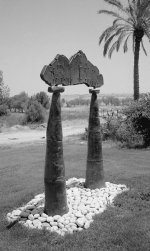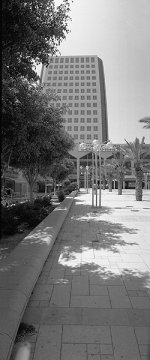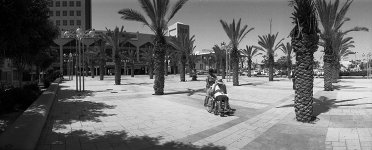alexz
Well-known
I ofetn hear that mantra (for B&W in particular) - it is recommended exposing the negs for shadows while developing for highlights.
However, as being briefly introduced to B&W processing theory by a friend of mine who is an educated pro photographer and artist, that during the development, at first stage, after certain threshold, highligths are developed and stay as they are (say in first several minutes of development of even less), all the rest of the dwevelopment time is treating mid tones and building shadow contrast towards the end of the development.
If so, I understand that there is no much control of highlights during development, but rather shadows can be well controlled by extending or somewhat shortening the development time. If so, how should I understand "developing for highlights" ? Shouldn't it be "developing for shadows" instead ? (and corespondingly exposing for highlights) ?
As per my understanding, given the highlights are developed at the beginning of the process and there is no muc control over them, exposure shall be tailoer to preserve highlights (since this is the only tool to control them), while by the development process we're able to control shadows...
Am I wrong ? Will be grateful for elaboration....
Thanks, Alex
However, as being briefly introduced to B&W processing theory by a friend of mine who is an educated pro photographer and artist, that during the development, at first stage, after certain threshold, highligths are developed and stay as they are (say in first several minutes of development of even less), all the rest of the dwevelopment time is treating mid tones and building shadow contrast towards the end of the development.
If so, I understand that there is no much control of highlights during development, but rather shadows can be well controlled by extending or somewhat shortening the development time. If so, how should I understand "developing for highlights" ? Shouldn't it be "developing for shadows" instead ? (and corespondingly exposing for highlights) ?
As per my understanding, given the highlights are developed at the beginning of the process and there is no muc control over them, exposure shall be tailoer to preserve highlights (since this is the only tool to control them), while by the development process we're able to control shadows...
Am I wrong ? Will be grateful for elaboration....
Thanks, Alex
markinlondon
Elmar user
It's the old zone system mantra, Alex. Highlight detail is lost in overdevelopment as the highlights "blow out".
The trouble with the ZS way is that it's not terribly useful for 36 shots taken under varying lighting conditions, the best we can hope to do is to control contrast reasonably across the range of exposures, hence developing for a fixed time.
The trouble with the ZS way is that it's not terribly useful for 36 shots taken under varying lighting conditions, the best we can hope to do is to control contrast reasonably across the range of exposures, hence developing for a fixed time.
marcust101
Established
I'll probably be corrected but I thought that mantra came from the zone system as used on Large format camera where negs would be developed singly or in small groups allowing this kind of control pic by pic
R
ruben
Guest
markinlondon said:.....
The trouble with the ZS way is that it's not terribly useful for 36 shots taken under varying lighting conditions...........
I very much agree and disagree (*). Nevertheless, perhaps i may add some positive things.
a) The story refers to Tri-x and Ilford films, owning the widest potential of F stops
b) You can very much apply it both in your exposures and developing, but when you speak about times, in the way you do, you are going somewhat to the intricate side of the stuff (however not necessarily to the wrong side)
c) In my opinion you can solve the issue by a systematic series of tests in exposure, developng and printing.
The first stage could be finding your feeling for compensating the exposures your averaging meter recommends you when metering shadows and black stuff under shadow. For a clue there is the concept of "undetailed black" and "detailed black". (As well as undetailed highlights and detailed highlights).
Then you can find the best developing time, enabling you to print your negative reproducing the shadows and black stuff in a middle of the way graduation of contrast, or paper "No 2". The idea is to have the time making your print as straight, or easy, as possible.
By this stage you have achieved half of the task. Don't discourage as the results will actively help you along your life.
Now that you control both exposure and time developing for detailed blacks under shadow, i, e, being able to easily print them, you start again the whole proceeding for having the best developing time for detailed white stuff under sunny light. Again you are looking for how much to compensate your meter reading. And again your judgement of exposure and film processing time will be printing with ease on No 2 paper or like filter graduation.
At this stage you will have 2 different film processing times, one for shadows and the other for highlights. Now, looking at prints, you should start to find the best compromise between the two you are ready to accept. This compromise, enabling you to easily print an image with both shadows and highlights in average No 2 paper, will be your achieved objective.
Of course, along your printing life, once you have mastered your film processing time, not every print will be easy breakfast. But many will be, and as for the hard ones, you will have achieved the best possible starting point. Printing may be very problematic due to the nature of the subject, but imagine yourself having to print such a problematic subject starting with wrong exposure and wrong film time processing...
Take note, that puposedly I have not phrased myself in terms of "exposing for shadow", or "developing for highlights", since this mess the whole thing at your darkroom. But when you will be, after the whole testing, in a photo situation in which you have not much shadows to meter, but highlights, knowing how to compensate them will automatically 'seat' you on the right exposure, as if you will be metering a shadow - from the practical point of view of the needs of your printing process.
Wow!, Mark has been wiser than me in avoiding the detail. (**)
Cheers,
Ruben
(*) After you have reached your measures for exposure compensation and film processing time, and use them along some 10 exposures in a roll, you will not be much deceived if the other frames in that roll were done using flash, or incident meter readings.
(**) Now, I hope every one understands that what I have said here is a crude popularization of the idea. For a real understanding of the stuff I have found and followed the books of DAVID VESTAL.
(***) The most basic and important idea, is that exposure, processing and printing are all interconnected, and once you find, upon testing, the best formula for you, you will gain forever both quality results, paper costs, and much time.
Last edited by a moderator:
markinlondon
Elmar user
Fabian
Established
@alex: There are two kinds of developers, one which developes the shadows first and the other one starts whith the highlights. This knowledge is from a very old book so I don't know how modern developers behave.
In may experience you control the shadows during exposure. That means if you have a very contrasty scene, for example a shadowed building in front of a blue sky, you have to meter for the shadow instead of the heaven.
That means you overexpose the sky and if you want to preserve some details in it (clouds) you have to shorten the development time.
I hope it helped a bit
Fabian
In may experience you control the shadows during exposure. That means if you have a very contrasty scene, for example a shadowed building in front of a blue sky, you have to meter for the shadow instead of the heaven.
That means you overexpose the sky and if you want to preserve some details in it (clouds) you have to shorten the development time.
I hope it helped a bit
Fabian
Jonathan R
Well-known
Alex, highlights do continue to build if you give extra development. That's why longer development times lead to higher contrast. In practice, because a film can only be SO black, there is a maximum beyond which highlight density can no longer increase - but the density of less bright areas can still catch up, hence extended development leads to blocked highlights.
At the other end of the scale, longer development will not generate shadow detail if you haven't given enough exposure to record it. All it will do its to increase shadow density through an increase in fog level.
In general, you want to avoid both over-exposure and over-development as you get increased fog levels and unprintable negatives. So, the old rule still applies, but it used to be easier when people were developing individual glass plates by inspection. It is not so easy to apply to a roll-film that contains images of a variety of subjects. One pragmatic solution is to use a 2-bath developer (e.g. Diafine, Emofin) which automatically restrains all high-light densities, and to expose adequately to record shadow detail where you want to see it. Get into the habit of studying your negs closely with a hand-lens, and you'll soon learn where you're going wrong or getting it right.
At the other end of the scale, longer development will not generate shadow detail if you haven't given enough exposure to record it. All it will do its to increase shadow density through an increase in fog level.
In general, you want to avoid both over-exposure and over-development as you get increased fog levels and unprintable negatives. So, the old rule still applies, but it used to be easier when people were developing individual glass plates by inspection. It is not so easy to apply to a roll-film that contains images of a variety of subjects. One pragmatic solution is to use a 2-bath developer (e.g. Diafine, Emofin) which automatically restrains all high-light densities, and to expose adequately to record shadow detail where you want to see it. Get into the habit of studying your negs closely with a hand-lens, and you'll soon learn where you're going wrong or getting it right.
alexz
Well-known
Wel, Fabian, if there is indeed two types of developers - one that develops shadows first and the secod develops highlights first, I guess "developing for highlights" would relate to the first type of developer, because apparently (per my understanding) first stage of the developing cannot be controlled (unless by agitation) so that the property that deveops first (be it shadows or highlights) is rather "automatic", i.e. cannot be controlled manually. If my understanding is correct, it sounds like the "mantra" is more appropriate to the developer type that process shadows first and does highlights towards the end of the processing time...
Yes, of course it sounds to be more appropriate to single sheet processing approach (LF), unless roll film contains similar kind of exposures...
Now will have to go though Ruben's response several time until ths stuff will settle down in my mind...
Yes, of course it sounds to be more appropriate to single sheet processing approach (LF), unless roll film contains similar kind of exposures...
Now will have to go though Ruben's response several time until ths stuff will settle down in my mind...
lZr
L&M
alexz
Well-known
Jonathan R said:Alex, highlights do continue to build if you give extra development. That's why longer development times lead to higher contrast. In practice, because a film can only be SO black, there is a maximum beyond which highlight density can no longer increase - but the density of less bright areas can still catch up, hence extended development leads to blocked highlights.
At the other end of the scale, longer development will not generate shadow detail if you haven't given enough exposure to record it. All it will do its to increase shadow density through an increase in fog level.
In general, you want to avoid both over-exposure and over-development as you get increased fog levels and unprintable negatives. So, the old rule still applies, but it used to be easier when people were developing individual glass plates by inspection. It is not so easy to apply to a roll-film that contains images of a variety of subjects. One pragmatic solution is to use a 2-bath developer (e.g. Diafine, Emofin) which automatically restrains all high-light densities, and to expose adequately to record shadow detail where you want to see it. Get into the habit of studying your negs closely with a hand-lens, and you'll soon learn where you're going wrong or getting it right.
Thanks Jonathan, I'm trying to comprehend your information.
I realized that longer development leads to increase in contrast, but I thought it is due to building shadows density (making shadows more deep into black) rather then by highlights.
As per your explanation, I understand (and please correct me if I'm wrong) that the very highlights are indeed developed at the beginning of the process to their amximum "satuartion" (black negative), but with continued development, the less bright areas (but still bright enough to approach "highlights") continue to get developed until reaching the "saturation" (black on film) just like the real highlights at the begninning of the processing. Thereby by extneded processing those "less bright" areas reach the absolute maximum density (black negative area) resulting in blocked highlighted areas. Am I correct ?
I understand of course that longer development will not generate details in shadows if these weren't recorded during proper exposure, but what I was initially missing (though probably due to particular scanner's resonse) - is the shadows contrast, not the details. Where was plenty of details in shadowed areas, but the shadows looked quite "weak" lacking the contrast (or depth). Once again, I'm not sure this is processing issue, chances I was messed up by my scanner's response and would I be wet printing I would realize that the negatives are OK in shadows as well.
This is why I thought slightly increase dev. time to achieve more depth in shadows (without blocking them though...)
R
ruben
Guest
alexz said:..............Now will have to go though Ruben's response several time until ths stuff will settle down in my mind...
Alex, by all means try to put your hands on a DAVID VESTAL book, and until then google about his extraordinary personality. You will be walking on the streets singing out of happiness.
Cheers,
Ruben
PS
I do own one, but it is so priceless to me that you either read it at my home, or deposit us$ 500 to borrow it. (and no smily)
alexz
Well-known
lZr said:Good ideas all of you.
Horizon S3 Pro pano. Exposure time: 1/125 f/16 Tmax 100 developed in HC-110 dilution B since yesterday
edit:
#1 is Bessa R with Color Scopar 35/2.5
Thanks for sharing Lazar.
I like the second one (sephia ?), while the third one shows a good cotntrol of dynamic range (preserved highlights with good details in shadows)...
BTW, how do you feel Tmax grain-wise ? Did you have the chances to compare it with other films (I have Plus-X in fridge, haven't yet tried one, but probably wuold consider it for portraiture hoping for smoother grain then Tri-X)...
lZr
L&M
Jonathan R
Well-known
Alex,
On the negative, the shadows are the least dense (least exposed) parts. If you increased their density while holding highlight density constant, the overall negative contrast would decrease.
Correct on the second part, except that density builds more gradually than you imply during development, even in extreme highlights. If you develop for only a short time, your negs will look very thin overall.
Scanners seem to vary a good deal in capturing shadow and highlight detail. If there is detail visible on the negative, you can certainly print it, and you should be able to capture it by scanning too. So study the negative with a hand lens and make sure your have captured the detail there.
You should certainly study the histogram of the scan to ensure it is not clipped at the shadow end. Assuming that it is not, your main control is by using Levels to set max black and white, and by using Curves to determine how the scale of tonal values is apportioned between those extremes. Usually (but not always) one can afford to flatten the curve at both ends. If your shadows look grey rather than black, the remedy is probably to set max black in Levels, then drag down the bottom of the curve.
Why not show us an example that disappoints you, to make sure we understand?
Good luck.
On the negative, the shadows are the least dense (least exposed) parts. If you increased their density while holding highlight density constant, the overall negative contrast would decrease.
Correct on the second part, except that density builds more gradually than you imply during development, even in extreme highlights. If you develop for only a short time, your negs will look very thin overall.
Scanners seem to vary a good deal in capturing shadow and highlight detail. If there is detail visible on the negative, you can certainly print it, and you should be able to capture it by scanning too. So study the negative with a hand lens and make sure your have captured the detail there.
You should certainly study the histogram of the scan to ensure it is not clipped at the shadow end. Assuming that it is not, your main control is by using Levels to set max black and white, and by using Curves to determine how the scale of tonal values is apportioned between those extremes. Usually (but not always) one can afford to flatten the curve at both ends. If your shadows look grey rather than black, the remedy is probably to set max black in Levels, then drag down the bottom of the curve.
Why not show us an example that disappoints you, to make sure we understand?
Good luck.
alexz
Well-known
ruben said:Alex, by all means try to put your hands on a DAVID VESTAL book, and until then google about his extraordinary personality. You will be walking on the streets singing out of happiness.
Cheers,
Ruben
PS
I do own one, but it is so priceless to me that you either read it at my home, or deposit us$ 500 to borrow it. (and no smily)
Thanks Ruben, I'll check him out...
P.S. everything has its price, you know...
John Bragg
Well-known
Hi, Alexz,
This is an excellent link to a site dedicated to the late Barry Thornton. He was an expert in the field of getting the best from a negative. Please read the section entitled UNZONE. It in particular explains the relationship between exposure and development in getting the best detail in shadows and highlights.
There is no great mystery involved except to say that shadows are largely governed by exposure, whilst the highlights are controlled more by development time, agitation etc.
http://www.barrythornton.com/
Regards, John.
PS also read the sections :- personal development time and personal film speed.
This is an excellent link to a site dedicated to the late Barry Thornton. He was an expert in the field of getting the best from a negative. Please read the section entitled UNZONE. It in particular explains the relationship between exposure and development in getting the best detail in shadows and highlights.
There is no great mystery involved except to say that shadows are largely governed by exposure, whilst the highlights are controlled more by development time, agitation etc.
http://www.barrythornton.com/
Regards, John.
PS also read the sections :- personal development time and personal film speed.
Last edited:
alexz
Well-known
Jonathan, please refer to my other related thread which deals exactly with nonsufficient shadows depth, there are examples attached (just straight scan, no Curves/Levels adjustments):
http://www.rangefinderforum.com/forums/showthread.php?p=580555#post580555
please refer to the examples in post #14 there...
If you will open the histogram of these images in PS, you will notice a limited contrast at the shadows (left end of the histogram)...
http://www.rangefinderforum.com/forums/showthread.php?p=580555#post580555
please refer to the examples in post #14 there...
If you will open the histogram of these images in PS, you will notice a limited contrast at the shadows (left end of the histogram)...
gns
Well-known
"As per my understanding, given the highlights are developed at the beginning of the process and there is no muc control over them, exposure shall be tailoer to preserve highlights (since this is the only tool to control them), while by the development process we're able to control shadows...
Am I wrong ? Will be grateful for elaboration...."
Yes, this is backwards. The old adage "expose for the shadows, dev. for the hightlights is correct". A little research on the zone system will spell this out best I think. Try the links/books noted in the above posts.
Yes, in practice the zone system is more easliy applicable for sheet film than roll film, but the realities of exposure and development of B&W film are the same for us all.
When you are out on a bright sunny day and you rate your tri-x at 200, then shorten the developing time, you are in fact using a sort of simplified zone system.
Good luck,
Gary
Am I wrong ? Will be grateful for elaboration...."
Yes, this is backwards. The old adage "expose for the shadows, dev. for the hightlights is correct". A little research on the zone system will spell this out best I think. Try the links/books noted in the above posts.
Yes, in practice the zone system is more easliy applicable for sheet film than roll film, but the realities of exposure and development of B&W film are the same for us all.
When you are out on a bright sunny day and you rate your tri-x at 200, then shorten the developing time, you are in fact using a sort of simplified zone system.
Good luck,
Gary
sirius
Well-known
I don't know much about developing so take this comment for what it's worth.
I've heard that you can bring more detail out of the highlights on film through a combination of development time, solution and agitation. There is more silver built-up in highlights. I've seen beautiful tones from a solution called Rhodinol. If there was not enough silver or exposure in the shadows then no developing technique can add more information.
Conversely with digital, a blown highlight is forever blown, while there is a lot of information that you can dig out of the shadows.
I hope my uneducated information is useful. Perhaps one of the many experts here can explain more...
I've heard that you can bring more detail out of the highlights on film through a combination of development time, solution and agitation. There is more silver built-up in highlights. I've seen beautiful tones from a solution called Rhodinol. If there was not enough silver or exposure in the shadows then no developing technique can add more information.
Conversely with digital, a blown highlight is forever blown, while there is a lot of information that you can dig out of the shadows.
I hope my uneducated information is useful. Perhaps one of the many experts here can explain more...
markinlondon
Elmar user
Share:
-
This site uses cookies to help personalise content, tailor your experience and to keep you logged in if you register.
By continuing to use this site, you are consenting to our use of cookies.




